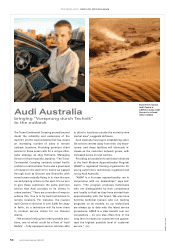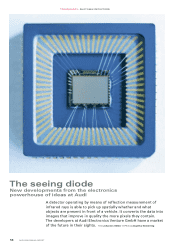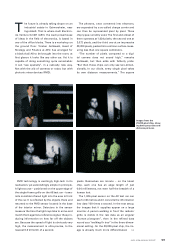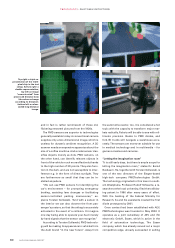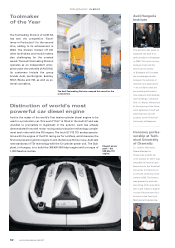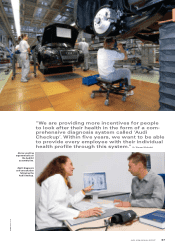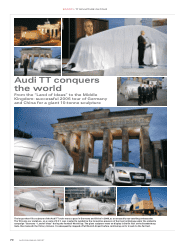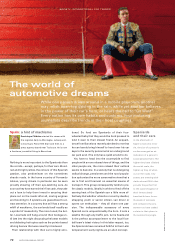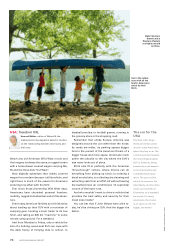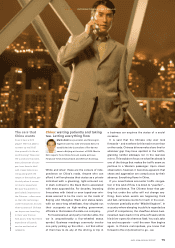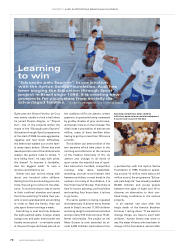Audi 2006 Annual Report Download - page 68
Download and view the complete annual report
Please find page 68 of the 2006 Audi annual report below. You can navigate through the pages in the report by either clicking on the pages listed below, or by using the keyword search tool below to find specific information within the annual report.
The dual vocational training system is
occasionally accused of forcing people
to specialise too early. Some claim that
a leaner basic training with modular
supplementary training would be better.
MORSCHHÄUSER: Thorough basic
training that engenders a passion for
learning, promotes independent initia-
tive and teaches the ability to learn is of
key importance specifically in paving
the way for further and advanced train-
ing in the course of professional life. Us-
ing this as a basis, continuous training
processes that must not be confined to
formal measures are needed to assure
an ongoing process of qualification
throughout a person’s working life. Over
70 percent of learning takes place infor-
mally within the working process. That is
why ideas focusing on learning-friendly
workplace organisation, teamwork, job
rotation and project assignments are
important. We need to integrate work-
ing and learning.
WIDUCKEL: We are specifically trying
out some new directions in the pilot
project “Human Resources Develop-
ment for Pay-Scale Employees”. For in-
stance, employees from toolmaking are
also deployed in the press shop. Partic-
ularly for committed employees, that
is an attractive proposition that
Grabber workshop learning
station: Dr. Widuckel with
apprentice mechatronics con-
structing Euro-type grabbers
for the Audi A5 body shop.
>>
SOCIETY: DEMOGRAPHIC CHANGE
66 AUDI 2006 ANNUAL REPORT
performance than their corresponding
age group was in 1950. So we are using
performance potential that used to be
fundamentally unavailable.
MORSCHHÄUSER: Forward-looking train-
i
ng and promotion of health is not
worthwhile for companies that are only
interested in their next set of business
figures. You have to plan on a longer
time horizon, like Audi. Nor is it possible
to quantify every achievement. How are
you supposed to measure a boost in
motivation or improved product quality
as a result of higher qualifications?
These are all significant factors, but
they cannot easily be expressed in
figures.
What is Audi doing to keep its workforce
in trim?
WIDUCKEL: We have done a tremen-
dous amount to reduce the rate of in-
dustrial accidents. We are at pains to
meet the highest possible ergonomic
standards. And we are providing more
incentives for people to look after their
health in the form of a comprehensive
diagnosis system called “Audi Checkup”.
Within five years, we want to be able
to provide every employee with their
individual health profile through this
system.
Is the workforce with you on that?
WIDUCKEL: The response is tremen-
dous. Employees receive a diagnosis
obtained using state-of-the-art medical
equipment, and expressed in the form
of a health profile. It is followed directly
by a consultation meeting where they
are given recommendations ranging
from medical treatments to mobility-
enhancing measures. The employees
appreciate and welcome this intensive
advice in particular. The Audi Checkup –
readily accessible, rapidly available
and with individual consultation – pro-
vides a quality of service that is unavail-
able in the public health system in this
form.
After all, every company wants to keep
its sickness figures as low as possible.
Might Audi stand accused of this being
just a publicity stunt?
MORSCHHÄUSER: I don’t think so. For a
start, the health check is only one of a
comprehensive package of measures,
accompanied by ergonomic and organi-
sational measures. Secondly, it is not
necessarily a question of inventing new
strategies. An age-appropriate employ-
ment and human resources policy may
also involve companies extending and
intensifying proven measures.


